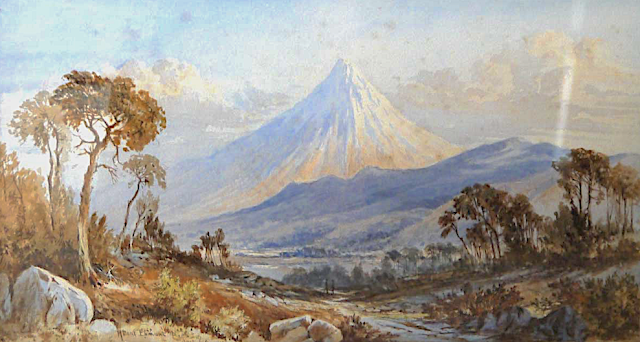-%20Milford%20Sound%20with%20Mount%20Pembroke%20Peak%20and%20Mitre%20Peak:rahotu%20,%201901%20watercolor%20on%20Bristol%20board-%20South%20Coast%20Antiques%20&%20Gallery.jpg)
LAURENCE WILLIAM WILSON (1850-1912)
Mitre Peak / Rahotu (1,683m - 5,522 ft)
Mont Pembroke ( 2,015m)
Nouvelle-Zélande
In Milford Sound with Mount Pembroke Peak and Mitre Peak/Rahotu 1901, watercolor on Bristol board- South Coast Antiques & Gallery
Les montagnes
Mitre Peak/ Rahotu (1 683 m)
est une montagne emblématique de Nouvelle-Zélande, située sur la rive
du Milford Sound (South Island). C'est l'un des sommets les plus
photographiés du pays. C'est la forme particulière évoquant un couvre
chef d'évêque chrétien, la mitre, qui a donné son nom à ce sommet. Il a
été nommé ainsi par le capitaine John Lort Stokes du HMS Acheron. Le
sommet jaillit du rivage de Milford Sound, dans le parc national de
Fiordland, au sud-ouest de l'île du Sud, offrant un spectacle
époustouflant. La montagne s'élève presque verticalement à partir de la
surface de l'eau qui est en réalité un fjord. Le pic est un ensemble
étroitement groupé de cinq pics, Mitre Peak n'étant même pas le plus
haut. Selon le point de vue ou l'on se place, Mitre Peak peut
apparaître comme un seul pic. Milford Sound fait partie de Te
Wahipounamu, un site inscrit du patrimoine mondial par l'UNESCO. Le seul
accès routier à Milford Sound se fait par la State Highway 94, l'une
des routes les plus pittoresques de Nouvelle-Zélande. Mitre Peak est
difficile à gravir et peu de gens le font. La première tentative a été
faite en 1883, mais a été avortée en raison du mauvais temps. La
tentative suivante eut lieu le 13 mars 1911 par JR Dennistoun de Peel
Forest. Il y a six voies jusqu'à Mitre Peak, et la plupart des grimpeurs
commencent par prendre un bateau pour Sinbad Bay.
Le mont Pembroke, ou Mount Pembroke en anglais, est un sommet de Nouvelle-Zélande. Il culmine à 2 015 mètres d'altitude au nord de Milford Sound, un fjord du parc national de Fiordland qui baigne sa base.
Le peintre
Laurence William Wilson
émigre à Auckland en 1877 puis voyage beaucoup avant de s'installer à
Dunedin en 1884. Il peint à la fois à l'huile et à l'aquarelle, devient
compagnon de peinture de George O'Brien puis professeur. L'un de ses
élèves fut 'artiste Dunedin Alfred O'Keefe. En 1895, LW Wilson avec
Grace Joel, Alfred O'Keefe, Jane Wimperis et Girolami Nerli formnt le Easel Club,
émanation artistique de l'établissement de Dunedin, qui offrait un
programme de cours spéciaux et l'introduction d'une femme modèle
professionnelle pour le nu. En 1904, LW Wilson quitta Dunedin pour
Melbourne où il passa 5 mois sur une peinture commandée de la ville
avant de partir pour l'Angleterre, retournant finalement en
Nouvelle-Zélande via l'Inde et l'Afrique. Il a exposé avec la Canterbury
Society of Arts en 1882 et l'Otago Art Society entre 1994 et 1904. Son
travail a été inclus dans l'exposition NZ and South Seas Dunedin 1889-90
et à l'exposition St Louis en 1904. LW Wilson est représenté dans le
collections de toutes les grandes galeries publiques de
Nouvelle-Zélande.
_________________________________________
2023 - Wandering Vertexes ....
Errant au-dessus des Sommets Silencieux...
Un blog de Francis Rousseau
-Mount%20Amstead,%20Rees%20River,%20%20Matukituki%20River,%20Watercolour-%20Christchurh%20Art%20GAllery-%20Te%20Puna%20o%20Waiwhetu.%20jpg.jpg)
